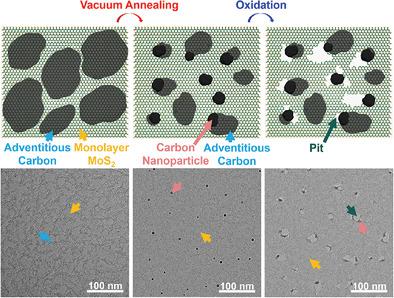当前位置:
X-MOL 学术
›
Adv. Mater.
›
论文详情
Our official English website, www.x-mol.net, welcomes your feedback! (Note: you will need to create a separate account there.)
Effect of Adventitious Carbon on Pit Formation of Monolayer MoS2.
Advanced Materials ( IF 29.4 ) Pub Date : 2020-08-02 , DOI: 10.1002/adma.202003020 Sangwook Park 1 , Samira Siahrostami 2 , Joonsuk Park 3 , Amir Hassan Bagherzadeh Mostaghimi 2 , Taeho Roy Kim 4 , Lauren Vallez 1 , Thomas Mark Gill 1 , Woosung Park 5 , Kenneth E Goodson 1 , Robert Sinclair 3 , Xiaolin Zheng 1
Advanced Materials ( IF 29.4 ) Pub Date : 2020-08-02 , DOI: 10.1002/adma.202003020 Sangwook Park 1 , Samira Siahrostami 2 , Joonsuk Park 3 , Amir Hassan Bagherzadeh Mostaghimi 2 , Taeho Roy Kim 4 , Lauren Vallez 1 , Thomas Mark Gill 1 , Woosung Park 5 , Kenneth E Goodson 1 , Robert Sinclair 3 , Xiaolin Zheng 1
Affiliation

|
Forming pits on molybdenum disulfide (MoS2) monolayers is desirable for (opto)electrical, catalytic, and biological applications. Thermal oxidation is a potentially scalable method to generate pits on monolayer MoS2, and pits are assumed to preferentially form around undercoordinated sites, such as sulfur vacancies. However, studies on thermal oxidation of MoS2 monolayers have not considered the effect of adventitious carbon (C) that is ubiquitous and interacts with oxygen at elevated temperatures. Herein, the effect of adventitious C on the pit formation on MoS2 monolayers during thermal oxidation is studied. The in situ environmental transmission electron microscopy measurements herein show that pit formation is preferentially initiated at the interface between adventitious C nanoparticles and MoS2, rather than only sulfur vacancies. Density functional theory (DFT) calculations reveal that the C/MoS2 interface favors the sequential adsorption of oxygen atoms with facile kinetics. These results illustrate the important role of adventitious C on pit formation on monolayer MoS2.
中文翻译:

不定碳对单层MoS2基坑形成的影响。
对于(光电)电,催化和生物应用,在二硫化钼(MoS 2)单层上形成凹坑是理想的。热氧化是在单层MoS 2上生成凹坑的潜在可扩展方法,并且假定凹坑优先形成于未配位的位点周围,例如硫空位。但是,有关MoS 2单层热氧化的研究尚未考虑不定碳(C)的影响,该碳在高温下普遍存在并与氧相互作用。此处,不定碳对MoS 2上凹坑形成的影响研究了热氧化过程中的单分子层。本文的原位环境透射电子显微镜测量结果表明,凹坑的形成优先在不定形C纳米颗粒和MoS 2之间的界面处开始,而不仅仅是硫空位。密度泛函理论(DFT)计算表明,C / MoS 2界面有利于以容易的动力学顺序吸附氧原子。这些结果说明了不定形C对单层MoS 2上的凹坑形成的重要作用。
更新日期:2020-09-15
中文翻译:

不定碳对单层MoS2基坑形成的影响。
对于(光电)电,催化和生物应用,在二硫化钼(MoS 2)单层上形成凹坑是理想的。热氧化是在单层MoS 2上生成凹坑的潜在可扩展方法,并且假定凹坑优先形成于未配位的位点周围,例如硫空位。但是,有关MoS 2单层热氧化的研究尚未考虑不定碳(C)的影响,该碳在高温下普遍存在并与氧相互作用。此处,不定碳对MoS 2上凹坑形成的影响研究了热氧化过程中的单分子层。本文的原位环境透射电子显微镜测量结果表明,凹坑的形成优先在不定形C纳米颗粒和MoS 2之间的界面处开始,而不仅仅是硫空位。密度泛函理论(DFT)计算表明,C / MoS 2界面有利于以容易的动力学顺序吸附氧原子。这些结果说明了不定形C对单层MoS 2上的凹坑形成的重要作用。


























 京公网安备 11010802027423号
京公网安备 11010802027423号